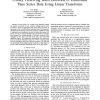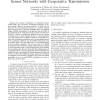48 search results - page 1 / 10 » Data Preservation in High Energy Physics - why, how and when |
HPDC
2006
IEEE
13 years 10 months ago
2006
IEEE
Grid computing has reached the stage where deployments are mature and many collaborations run in production mode. Mature Grid deployments offer the opportunity for revisiting and ...
NN
2002
Springer
13 years 4 months ago
2002
Springer
The ability to grow extra nodes is a potentially useful facility for a self-organising neural network. A network that can add nodes into its map space can approximate the input sp...
CIDM
2007
IEEE
13 years 11 months ago
2007
IEEE
— In this paper, we consider burst detection within the context of privacy. In our scenario, multiple parties want to detect a burst in aggregated time series data, but none of t...
ICC
2007
IEEE
13 years 11 months ago
2007
IEEE
— We consider combination of Distributed Source Coding (DSC) and cooperative transmission techniques to improve energy efficiency in sensor networks. To start with we formulate ...
SIGMOD
2001
ACM
14 years 4 months ago
2001
ACM
In this paper, we investigate how to scale hierarchical clustering methods (such as OPTICS) to extremely large databases by utilizing data compression methods (such as BIRCH or ra...


